David Scott
| David Randolph Scott | |
|---|---|
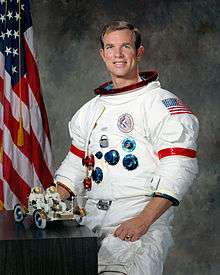 | |
| NASA astronaut | |
| Nationality | American |
| Status | Retired |
| Born |
David Randolph Scott June 6, 1932 San Antonio, Texas, U.S. |
Other occupation | Test pilot |
|
University of Michigan USMA, B.S. 1954 MIT, M.S. and E.A.A. 1962 | |
| Rank | Colonel, USAF |
Time in space | 22d 18h 53m |
| Selection | 1963 NASA Group 3 |
Total EVAs | 5 (Stand up EVA on Apollo 9, 4 EVAs on Apollo 15: 1st EVA was a stand-up, while 3 EVAs were on the moon surface)[1] |
Total EVA time | 20 hours 35 minutes[2][3] |
| Missions | Gemini 8, Apollo 9, Apollo 15 |
Mission insignia |
|
| Retirement | October 30, 1977 |
| Awards |
|
David Randolph "Dave" Scott (born June 6, 1932), (Col, USAF, Ret.), is an American engineer, retired U.S. Air Force officer, former test pilot, and former NASA astronaut. He belonged to the third group of NASA astronauts, selected in October 1963. As an astronaut, Scott became the seventh person to walk on the Moon.
Before becoming an astronaut, Scott graduated from the United States Military Academy at West Point and joined the United States Air Force. He graduated from the Air Force Experimental Test Pilot School (Class of 1963) and Aerospace Research Pilot School (Class of 1964).[4] Scott retired from the Air Force in 1975 with the rank of colonel, and more than 5,600 hours of logged flying time.
As an astronaut, Scott made his first flight into space as pilot of the Gemini 8 mission, along with Neil Armstrong, in March 1966, spending just under eleven hours in low Earth orbit. Scott then spent ten days in orbit as Command Module Pilot aboard Apollo 9, his second spaceflight, along with Commander James McDivitt and Lunar Module Pilot Rusty Schweickart. During this mission, Scott became the last American to fly solo in Earth orbit (not counting subsequent untethered EVAs). Scott made his third and final flight into space as commander of the Apollo 15 mission, the fourth human lunar landing, becoming the seventh person to walk on the Moon and the first person to drive on the Moon.
Early life and education
Scott was born June 6, 1932, on Randolph Field (for which he received his middle name) near San Antonio, Texas and was active in the Boy Scouts of America where he achieved its second highest rank, Life Scout.[5] Scott was educated at Texas Military Institute, Riverside Polytechnic High School in Riverside, California, where he joined the swim team and set several state and local swim records. Scott attended The Western High School in Washington, D.C. graduating in June 1949. In D.C. he was an honor student, on the school swim team and the Ambassador Hotel AAU champion team as a record setter. He attended the University of Michigan for one year where he was an honor student in the Engineering school, a member of the swimming team and pledged Sigma Chi fraternity before receiving an invitation to attend West Point, where he graduated with a Bachelor of Science degree, finishing 5th in his class out of 633, in 1954. Because of his high standing in the class, he was able to choose which branch of the military he would serve. Scott chose the Air Force because he wanted to fly jets. He was assigned to the 32d Tactical Fighter Squadron at Soesterberg Air Base (RNAF), Netherlands, from April 1956 to July 1960. Upon completing this tour of duty, he returned to the United States for study at the Massachusetts Institute of Technology.[6] He received both a Master of Science degree in Aeronautics/Astronautics and the degree of Engineer in Aeronautics/Astronautics (the E.A.A. degree) from MIT in 1962.[7] He also received an Honorary Doctorate of Astronautical Science from the University of Michigan in 1971. In 1959 he married his first wife, Ann. He also has two children with her: Tracy (born 1961) and Douglas (born 1963).[8] He is of Scottish descent, and his recreational interests include swimming, handball, skiing, and photography.
NASA career

Scott was the first of the Group Three astronauts to be selected to fly and was also the first to command a mission of his own.
Gemini 8
On March 16, 1966, Scott and Command Pilot Neil Armstrong were launched into space on the Gemini 8 mission, a flight originally scheduled to last three days, in which Scott was to perform an EVA, but terminated early due to a malfunctioning thruster. The crew performed the first successful docking of two vehicles in space and demonstrated great piloting skill in overcoming the thruster problem and bringing the spacecraft to a safe landing. Scott would later perform EVAs on his two subsequent flights.
Apollo 9

Scott served as Command Module Pilot for Apollo 9 (March 3–13, 1969). This was the third manned flight in the Apollo series, the second to be launched by a Saturn V, and the first to complete a comprehensive earth-orbital qualification and verification test of a "fully configured Apollo spacecraft." The ten-day flight provided vital information previously not available on the operational performance, stability, and reliability of lunar module propulsion and life support systems. Highlight of this evaluation was completion of a critical lunar-orbit rendezvous simulation and subsequent docking, initiated by James McDivitt and Rusty Schweickart from within the Lunar Module at a separation distance which exceeded 100 miles (160 km) from the command/service module piloted by Scott. The crew also demonstrated and confirmed the operational feasibility of crew transfer and extravehicular activity techniques and equipment, with Schweickart completing a 46-minute EVA outside the Lunar Module. During this period, Dave Scott completed a 1-hour stand-up EVA in the open Command Module hatch photographing Schweickart's activities and also retrieving thermal samples from the Command Module exterior. Apollo 9 splashed down less than four nautical miles (7 km) from the helicopter carrier USS Guadalcanal (LPH-7).
In his next assignment, Scott was designated backup spacecraft commander for Apollo 12.
Apollo 15
"Man must explore. And this is exploration at its greatest."
David Scott[9]
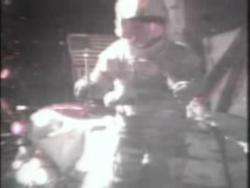
Scott made his third space flight as spacecraft commander of Apollo 15 (July 26–August 7, 1971). His companions on the flight were Alfred M. Worden (Command Module Pilot) and James B. Irwin (Lunar Module Pilot). Apollo 15 was the fourth successful manned lunar landing mission and the first to land near mountains instead of the relatively flat mare region where the previous three missions had landed. The landing site was between Hadley Rille and Apennine Mountains which are located on the southeast edge of the Mare Imbrium (Sea of Rains). After landing, Scott and Irwin donned their pressure suits and Scott performed the first and only stand up EVA on the lunar surface, by poking his head out the docking port on top of the Lunar Module. He took panoramic photographs of the surrounding terrain from an elevated position and scouted the terrain they would be driving across the next day. The Lunar Module, Falcon, remained on the lunar surface for 66 hours and 54 minutes (setting a new record for lunar surface stay time) and Scott and Irwin logged 18 hours and 35 minutes each in extravehicular activities conducted during three separate excursions onto the lunar surface. Using "Rover-1" to transport themselves and their equipment along portions of Hadley Rille and the Apennine Mountains, Scott and Irwin performed a selenological inspection and survey of the area and collected 180 pounds (82 kg) of lunar surface materials. They deployed an ALSEP package which involved the emplacement and activation of surface experiments, and their lunar surface activities were televised using a TV camera which was operated remotely by ground controllers stationed in the Mission Control Center located at Houston, Texas. Other Apollo 15 achievements include: largest payloads ever placed into earth and lunar orbits; first scientific instrument module (SIM) bay flown and operated on an Apollo spacecraft; longest distance traversed on lunar surface; first use of a lunar surface navigation device (mounted on Rover-1); first subsatellite launched in lunar orbit; and first extravehicular (EVA) from a Command Module during transearth coast. The latter feat was performed by Worden during three excursions to Endeavour's SIM-bay where he retrieved film cassettes from the panoramic and mapping cameras and reported his personal observations of the general condition of equipment housed there. Apollo 15 concluded with a Pacific Ocean splashdown and subsequent recovery by USS Okinawa.
Organizations
Scott is a fellow of the American Astronautical Society, associate fellow of the American Institute of Aeronautics and Astronautics, and member of the Society of Experimental Test Pilots, and Tau Beta Pi, Sigma Xi and Sigma Gamma Tau.
Awards and honors
Scott has been awarded two NASA Distinguished Service Medals, a NASA Exceptional Service Medal, two Air Force Distinguished Service Medals, the Distinguished Flying Cross, the Air Force Association's David C. Schilling Trophy, the Fédération Aéronautique Internationale Gold Medal, the United Nations Peace Medal, and the Robert J. Collier Trophy.
In the 1998 television series From the Earth to the Moon Scott was portrayed by Brett Cullen.
Apollo 15 controversies
Two non-essential items brought along on Apollo 15 were the subject of later controversy.
Stamp incident
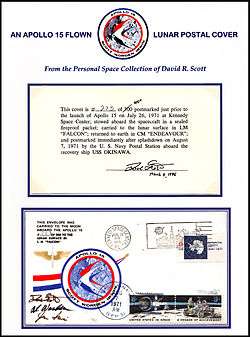
Before the mission, the crew had made an agreement with a stamp dealer, similar to those made by other Apollo crews, to carry some signed first day covers along to the moon that could be sold later to collectors. Their goal was to provide for their families, and they established that the proceeds would go into a trust fund for their children's education, on the belief that the covers would not be sold for some time.[10]
The crew took 398 covers to the moon with them. Later it was alleged that these had been smuggled on board. In his 2013 book Two Sides of the Moon, Scott says that was impossible as the astronauts had to account for everything they took on board, including personal items. Instead of personally certifying the Apollo 15 crews as he usually did, Deke Slayton deferred to the flight-support crew, according to Scott. The support team's manifest did not include the covers.[10]
Once the mission was over a German stamp dealer began selling the first day covers immediately. The astronauts objected and said they did not want the money. When the sales were reported in the press some members of U.S. Congress became angry that they heard about them first that way, instead of from NASA itself, especially in the wake of an incident involving silver medallions taken along on Apollo 14. Slayton claimed in his autobiography that he felt Scott, Worden and Irwin had embarrassed NASA and the Apollo program by trying to profit in such way from the hard work that had gone into the Apollo 15 mission, and violated NASA rules.[11]
Scott wrote later that a "witch hunt" mentality took hold. The astronauts were advised to retain independent legal counsel before testifying at a closed Senate hearing on the matter. None of them would go into space again, and Scott wrote later that "NASA had hung us out to dry," to assuage Congressional anger over the apparent commercialization of earlier Apollo flights. In 1978 the Justice Department concluded that while the crew had broken some space-agency rules, they did nothing illegal. The covers were legal, they had not been intended for sale, the crew had not smuggled them on board and NASA would have approved letting them do so had they been asked. "We were reprimanded and took our licks. But it was a very raw deal," recalls Scott.
Fallen Astronaut
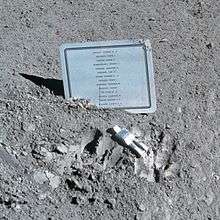
The crew also brought along a 3 1/2-inch (8.9 cm) statue, Fallen Astronaut, which Scott placed on the rim of Hadley Rille along with a plaque listing the names of 14 astronauts and cosmonauts who had died during training. While Scott had been under the impression that it was intended as a memorial, Belgian sculptor Paul Van Hoeydonck had created it as a tribute to humanity's aspirations to expand into space. Scott believed that the agreement with van Hoeydonck allowed the sculptor to make a single copy for sale, and no more.[12]
Although it was the first (and so far only) sculpture exhibited on the moon, NASA did not discuss it much and did not identify van Hoeydonck as the artist for some time afterwards, which the artist believed was a deliberate slight engineered by Scott, since Van Hoeydonck had been unhappy that his work had been used as a memorial. He was invited to the launch of Apollo 16 and interviewed by Walter Cronkite.[12] Afterwards, he announced plans to sell copies of Fallen Astronaut through a New York art gallery. Scott wrote him letters expressing the crew's disappointment that he had chosen not to honor their agreement. Van Hoeydonck and his dealer went ahead with the plan, but only one copy sold. Relations between Scott and Van Hoeydonck remain strained.[12]
Post-NASA career
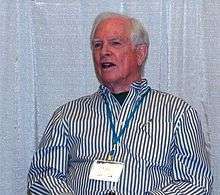
- On April 18, 1975, at age 42, Scott became the Center Director of NASA's Flight Research Center, a position he held until October 30, 1977.
- He was later President of Scott Science and Technology, Inc.
- He commentated for British TV on the first Space Shuttle flight (STS-1) in April 1981.
- He also consulted on the movies Apollo 13 for Ron Howard and was on the set for much of the filming of the 1998 HBO miniseries From the Earth to the Moon, where he advised both Tom Hanks and the various directors, as well as answered questions from the actors on set.
- In 2000 he was briefly engaged to British television newscaster Anna Ford.[13]
- In 2003–2004 he consulted on the BBC TV series Space Odyssey: Voyage To The Planets.
- In 2004, he and former Soviet cosmonaut Alexei Leonov began work on a dual biography / history of the "Space Race" between the United States and the Soviet Union. The book, Two Sides of the Moon: Our Story of the Cold War Space Race was published in 2006. Neil Armstrong and Tom Hanks both wrote introductions to the book.
- He currently resides in Los Angeles, California with his wife, Margaret.
- Scott is one of the astronauts featured in the book and documentary In the Shadow of the Moon, and was instrumental in helping to get the film off the ground.
See also
References
- ↑ "Extravehicular Activity". NASA history. Retrieved 29 June 2016.
- ↑ Joachim Becker. "David Scott - EVA experience".
- ↑ "Biographies of Other Apollo Astronauts". NASA. Retrieved 29 June 2016.
- ↑ "Dave Scott - Astronaut Scholarship Foundation".
- ↑ "Astronauts and the BSA". Fact sheet. Boy Scouts of America. Retrieved 2006-03-20.
- ↑ Two Sides of the Moon, PP18-28
- ↑ "To the moon, by way of MIT". Web.mit.edu. 2009-06-03. Retrieved 2010-03-05.
- ↑ Davies, Hugh; Rozenberg, Joshua (July 21, 2001). "Anna Ford's affair with ex-astronaut burns out". London: Daily Telegraph. Retrieved 2011-03-07.
- ↑ "Scott, David R. (1932-)".
- 1 2 Scott, David; Leonov, Alexei (2013). Two Sides of the Moon: Our Story of the Cold War Space Race. MacMillan. pp. 385–388. ISBN 9781466859272. Retrieved December 17, 2013.
- ↑ Deke Slayton. Deke!. ISBN 978-0-312-85918-3.
- 1 2 3 Powell, Corey S.; Shapiro, Laurie Gwen (December 16, 2013). "The Sculpture on the Moon". Slate. Retrieved December 17, 2013.
- ↑ Smith, Andrew (2005). Moondust: in search of the men who fell to Earth. New York: Fourth Estate. pp. 324–325. ISBN 978-0-00-715541-5. OCLC 58720734.
Books
- Scott, David; Alexei Leonov (2006). Two Sides of the Moon: Our Story of the Cold War Space Race. with Christine Toomey. St. Martin's Griffin. ISBN 0-312-30866-3.
- Some years after his career at NASA concluded, Scott wrote this book with Alexei Leonov, the first person to walk in space, about being on opposite sides of the space race during the Cold War.
- In the Shadow of the Moon, Francis French and Colin Burgess, UNP, 2007.
External links
| Wikimedia Commons has media related to David Scott. |
- Scott's official NASA biography
- Astronautix biography of David R. Scott
- Spacefacts biography of David R. Scott
- Scott at Encyclopedia of Science
- David Scott at the Internet Movie Database

